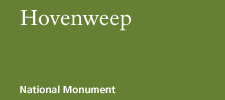The science of archeology has contributed to our
knowledge some of the most fascinating chapters in culture history, for
it has brought to light, from the night of the past, periods of human
development hitherto unrecorded. As the paleontologist through his
method has revealed faunas whose like were formerly unknown to the
naturalist, the archeologist by the use of the same method of research
has resurrected extinct phases of culture that have attained a high
development and declined before recorded history began. No achievements
in American anthropology are more striking than those that, from a study
of human buildings and artifacts antedating the historic period, reveal
the existence of an advanced prehistoric culture of man in America.
The evidences of a phase of culture that had
developed and was on the decline before the interior of North America
was explored by Europeans are nowhere better shown than in southwestern
Colorado, New Mexico, Arizona, and Utah, the domain of the
Cliff-dwellers, or the cradle of the Pueblos. There flourished on what
is now called the Mesa Verde National Park, in prehistoric times, a
characteristic culture unlike that of any region in the United States.
This culture reached its apogee and declined before the historic epoch,
but did not perish before it had left an influence extending over a wide
territory, which persisted into modern times. Through the researches of
archeologists the nature of this culture is now emerging into full view;
but much material yet remains awaiting investigation before it can be
adequately understood. The purpose of this article is to call attention
to new observations bearing upon its interpretation made by the author,
under the auspices of the Bureau of American Ethnology, on brief trips
to Colorado and Utah in 1917 and 1918.
The peculiar cliff-dwellings and open-air villages of
the Mesa Verde are here shown to be typical of those found over a region
many miles in extent. They indicate a distinct culture area, which is
easily distinguished from others where similar buildings do not exist,
but not as readily separated from that of adjacent
regions where the buildings are superficially similar but structurally
different. In order to distinguish it from its neighbors and determine
its horizon, we must become familiar with certain architectural
characteristics. As our knowledge of the character of buildings in this
area is incomplete, the intention of the author is to define the
several different types of buildings that characterize it.
When, in 1915, there was brought to light on the Mesa
Verde National Park, Colorado, the mysterious structure, Sun Temple, the
author recalled well-known descriptions of towers and other related
buildings that have been recorded from other localities in southwestern
Colorado and Utah. The published descriptions of these structures did
not seem to him adequate for comparisons, and he planned an examination
of these great houses and towers, hoping to gather new data that would
shed some light on his interpretation of Sun Temple. During the field
work in 1917, thanks to an allotment from the Bureau of American
Ethnology for that purpose, he undertook a reconnoissance in the McElmo
district, where similar buildings are found and where he believed
cultural relatives of the former inhabitants of Mesa Verde once lived.
In 1918 he extended his field work still farther. He investigated ruins
as far as the western tributaries of the Yellow Jacket Canyon,
penetrating a short distance beyond the Colorado border into Utah. The
object of the following pages is to make known the more important
results of this visit, and interpret the evidence they present as a
contribution to our knowledge of the extension in prehistoric times of
the Mesa Verde culture area.



